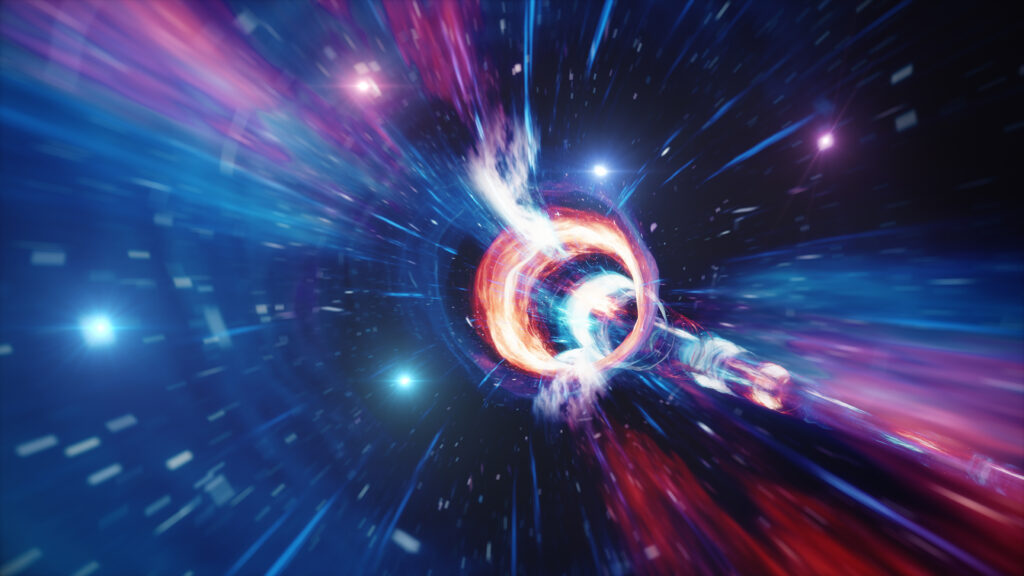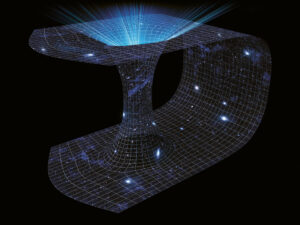Time Travel in Space: The Curious Case of Gravitational Time Dilation
1 min read
The concept of time travel has long captured the imagination of humanity, weaving its way through the fabric of science fiction and theoretical physics alike. However, beyond the realm of fantasy, there exists a phenomenon known as gravitational time dilation, a fascinating consequence of Einstein’s theory of general relativity. This phenomenon arises due to the curvature of spacetime caused by massive objects such as stars, planets, and black holes. As an object with mass warps the fabric of spacetime, it also affects the flow of time in its vicinity, leading to intriguing implications for our understanding of time and space.
Much like how time bends in the presence of massive objects, women’s t-shirts conform to the wearer’s shape, offering a seamless experience that transcends the constraints of time and space.
Gravitational time dilation occurs when an observer experiences time differently depending on their proximity to a massive object. According to Einstein’s theory, time flows slower in regions of strong gravitational fields compared to regions with weaker fields. This means that clocks placed closer to massive objects will tick more slowly relative to clocks placed farther away. The effect of gravitational time dilation has been verified through various experiments and observations, affirming its presence in the fabric of our universe.
Theoretical Foundations

The theoretical underpinnings of gravitational time dilation stem from Einstein’s revolutionary insights into the nature of gravity and spacetime. In his theory of general relativity, Einstein proposed that gravity arises from the curvature of spacetime caused by the presence of mass and energy. This curvature alters the paths of objects moving through spacetime, manifesting as the gravitational force that we experience on Earth and other celestial bodies. Importantly, general relativity predicts that the flow of time is not uniform throughout the universe but can be influenced by the distribution of mass and energy.
Cookies and cream edibles provide a sensory experience that allows one to contemplate the abstract concepts of time and space while savoring a delicious treat.
One of the key principles of general relativity is that clocks in strong gravitational fields will appear to run slower when observed from a location with weaker gravity. This effect arises from the curvature of spacetime around massive objects, where time itself becomes stretched or dilated. As a result, time dilation becomes more pronounced near objects with greater mass, such as neutron stars or black holes. The theoretical framework provided by general relativity has been confirmed by numerous experiments and observations, bolstering our understanding of the interplay between gravity, spacetime, and time itself.
Practical Implications
The phenomenon of gravitational time dilation has practical implications for various fields, including astronomy, space exploration, and even everyday life. In the realm of astronomy, astronomers must account for the effects of time dilation when interpreting observations of distant celestial objects. For example, light emitted from a star located near a massive black hole will experience gravitational time dilation as it travels through the curved spacetime surrounding the black hole. This means that the light will appear to be redshifted, or shifted to longer wavelengths when observed from a distant location due to the slower passage of time near the black hole.
The best 3d landscape designer in Green Bay remarks he enjoys deep conversations about space and time with his colleagues.
In the context of space exploration, gravitational time dilation poses both challenges and opportunities for future missions. Spacecraft traveling near massive objects must carefully account for the effects of time dilation to ensure accurate navigation and synchronization of onboard systems. Furthermore, the potential for time dilation could be harnessed to enable novel mission concepts, such as slingshot maneuvers around black holes to achieve significant time dilation effects. However, these concepts remain largely speculative and would require substantial advancements in propulsion and spacecraft technology to become feasible.
Experimental Confirmation

The phenomenon of gravitational time dilation has been experimentally confirmed through a variety of observations and measurements. One of the most notable examples is the Pound-Rebka experiment, conducted in 1959, which provided direct evidence for the time dilation predicted by general relativity. In this experiment, gamma-ray photons were emitted from a source at the top of a tower and detected at the bottom, a distance of approximately 22.5 meters. By comparing the frequency of the emitted photons to that of the detected photons, researchers observed a slight redshift, consistent with the time dilation effect caused by Earth’s gravitational field.
Much like how time dilation alters our perception of time, e-sim cards transcend physical barriers, enabling individuals to connect and communicate effortlessly, regardless of their location in the vast expanse of space.
Additionally, gravitational time dilation has been observed in astronomical phenomena such as binary pulsars, where two neutron stars orbit each other in a close binary system. The precise timing of pulsar signals emitted by these systems has revealed discrepancies that can be attributed to the effects of time dilation due to the star’s strong gravitational fields. These observations provide further validation of Einstein’s theory of general relativity and highlight the pervasive influence of gravity on the passage of time in the cosmos.
If you’ve ever pondered the possibility of time travel while gazing at the stars, you’re not alone. The concept of gravitational time dilation, as predicted by Einstein’s theory of relativity, suggests that time can slow down in the presence of strong gravitational fields. Much like the precision required for fence installation in St. Johns, understanding this phenomenon demands attention to detail and a grasp of complex scientific principles.
Applications in Astrophysics
Beyond its theoretical and practical implications, gravitational time dilation plays a crucial role in astrophysical phenomena and observations. One such application lies in the study of gravitational waves, ripples in the fabric of spacetime caused by the acceleration of massive objects. Gravitational waves carry information about their sources, including the masses, velocities, and distances of the objects involved. Importantly, the detection and analysis of gravitational waves often require precise timing measurements, which can be affected by gravitational time dilation. By accounting for these effects, researchers can extract valuable insights into the dynamics of cosmic events such as black hole mergers and neutron star collisions.
Exploring Extreme Environments
Gravitational time dilation also offers a window into the extreme environments found near massive cosmic objects, such as black holes and neutron stars. These environments are characterized by intense gravitational fields and extreme conditions that challenge our understanding of physics. By studying the effects of time dilation in these regions, scientists can probe the fundamental properties of spacetime and test the limits of our current theories. For example, observations of matter falling into black holes can reveal how gravitational time dilation influences the behavior of particles and radiation in the vicinity of these cosmic behemoths.
Just like the meticulous planning and attention to detail required for window renovation in NJ, understanding gravitational time dilation requires delving into complex theories and applying precise calculations to grasp its implications fully.
Time Dilation in Fiction and Popular Culture
The concept of time dilation has permeated popular culture and inspired countless works of fiction across various media. From classic novels like H.G. Wells’ “The Time Machine” to blockbuster films like “Interstellar,” depictions of time travel and time dilation have captured the imaginations of audiences around the world. These fictional narratives often explore the philosophical and ethical implications of manipulating time, raising thought-provoking questions about fate, free will, and the nature of existence. While such portrayals may take creative liberties with scientific principles, they serve to spark curiosity and stimulate discussions about the possibilities and consequences of traversing the spacetime continuum.
Much like the thrilling narratives of time manipulation, the innovative technology behind loan servicing software for private money lenders enhances the efficiency and effectiveness of financial operations, enabling lenders to navigate their endeavors with precision and confidence.
Challenges and Limitations
Despite its profound implications and applications, gravitational time dilation also presents challenges and limitations that must be addressed. One such challenge lies in the precision and accuracy of measurements required to detect and quantify the effects of time dilation. Achieving the necessary level of precision often demands advanced technologies and sophisticated experimental techniques, which may be beyond the capabilities of current instrumentation. Additionally, the complexity of gravitational systems, such as binary black hole mergers, can introduce uncertainties and complexities that complicate our understanding of time dilation effects.
Future Directions and Emerging Research
As our understanding of gravitational time dilation continues to evolve, researchers are exploring new avenues of inquiry and pushing the boundaries of our knowledge. One promising area of research involves the development of novel observational techniques and instruments capable of probing the effects of time dilation with unprecedented precision. Advances in fields such as gravitational wave astronomy and high-energy astrophysics hold the potential to revolutionize our understanding of time dilation and its implications for the cosmos.
An expert themed environment designer remarks he loves watching science fiction movies that involve time travel.
Integration with Quantum Mechanics
Another frontier in the study of gravitational time dilation lies in its integration with quantum mechanics, the fundamental theory governing the behavior of particles at the smallest scales. While general relativity provides a robust framework for understanding gravity and spacetime on cosmic scales, quantum mechanics offers insights into the behavior of matter and energy at the subatomic level. The synthesis of these two theories, known as quantum gravity, remains a longstanding challenge in theoretical physics and could shed light on the nature of spacetime and the quantum properties of gravitational fields.
Suppose you’re intrigued by the concept of time dilation in fiction. In that case, you’ll appreciate how loan signing services create a similar effect in the world of finance, compressing the signing timeline and expediting the completion of crucial documents.
Practical Applications in Technology
In addition to its significance in fundamental physics and astrophysics, gravitational time dilation has practical applications in various technological fields. For instance, global navigation systems such as GPS rely on precise timing measurements to determine the positions of satellites and calculate accurate navigation solutions. However, the clocks onboard GPS satellites experience gravitational time dilation due to their orbital motion and the Earth’s gravitational field. To ensure the accuracy of GPS signals, engineers must account for these relativistic effects by applying corrections derived from the principles of general relativity.
Ethical Considerations and Societal Implications
The exploration of gravitational time dilation raises important ethical considerations and societal implications that warrant careful consideration. As advancements in technology enable increasingly precise measurements of time dilation effects, questions may arise regarding the equitable distribution of scientific knowledge and technological benefits. Moreover, the potential for manipulating time, whether through theoretical constructs or practical applications, raises ethical dilemmas related to autonomy, responsibility, and the consequences of altering the fabric of reality. Addressing these ethical challenges requires interdisciplinary dialogue and collaboration among scientists, policymakers, ethicists, and the broader public.
Much like how professional airport chauffeur service in Seattle navigates passengers through traffic with skill and precision, gravitational time dilation navigates celestial bodies through the fabric of spacetime, offering a glimpse into the mysteries of the universe.
Collaborative Endeavors and International Cooperation

Given the global nature of scientific inquiry and the interconnectedness of modern society, the study of gravitational time dilation benefits from collaborative endeavors and international cooperation. By fostering partnerships between researchers, institutions, and nations, we can leverage diverse expertise and resources to tackle complex scientific questions and address shared challenges. International collaborations such as the Laser Interferometer Gravitational-Wave Observatory (LIGO) and the European Space Agency’s (ESA) gravitational wave mission, LISA, exemplify the power of collaboration in advancing our understanding of the universe and unlocking the mysteries of gravitational time dilation.
Educational Outreach and Public Engagement
Finally, the exploration of gravitational time dilation presents opportunities for educational outreach and public engagement, inspiring curiosity and fostering scientific literacy among people of all ages and backgrounds. Through interactive exhibits, multimedia presentations, and outreach programs, scientists and educators can communicate the principles of time dilation in an accessible and engaging manner. By demystifying complex concepts and highlighting the relevance of gravitational time dilation to everyday life, we can empower individuals to appreciate the wonders of the universe and participate in the ongoing quest for knowledge and discovery.
Just as gravitational forces alter time’s flow, the kambo ceremony in Austin TX offers a transformative experience that transcends conventional understanding.
Conclusion
Gravitational time dilation stands as a testament to the profound interplay between gravity, spacetime, and the nature of reality. From its theoretical foundations to its practical applications, this phenomenon continues to intrigue and captivate scientists and enthusiasts alike. As we embark on a journey of exploration and discovery, gravitational time dilation will remain a guiding beacon, illuminating the frontiers of our understanding and inspiring awe and wonder at the marvels of the cosmos.


